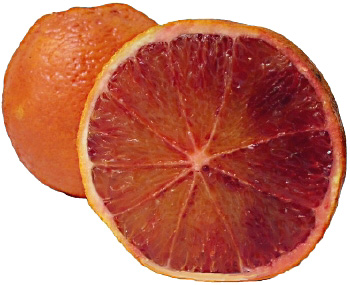...Best of Sicily presents... Best of Sicily Magazine. ... Dedicated to Sicilian art, culture, history, people, places and all things Sicilian. |
by Roberta Gangi | ||
Magazine Index Best of Sicily Arts & Culture Fashion Food & Wine History & Society About Us Travel Faqs Contact Map of Sicily |
Cultivation of oranges gradually spread through China and India to east Africa and then to the Mediterranean region. The trees enjoy a mild climate, sunny weather and good drainage. An occasional frost or chill does not harm them. Originally, oranges had seeds. The navel orange (which Italians call the "brasiliana") was developed in the United States. Blood oranges are so called for their red flesh and deep red juice. When ripe, their skin may also be reddish, at least in part. In the British Empire, blood oranges were called "Maltese" oranges, and are closely related to Jaffa oranges. In Sicily, the most popular blood oranges are the Tarocco, the Moro and the Sanguigno, the latter cultivated extensively in the eastern part of the island as the Sanguinello (shown here) of Paternò and Adernò. Though consumed in salads and desserts, blood oranges are favored for their distinctive red juice which, as it happens, is exceptionally healthy, being rich in antioxidants. Blood oranges are rarely very sweet. Mandarins, Valencias and navel oranges are also grown in Sicily, but the blood orange is considered particularly Sicilian, perhaps because it is not as widely cultivated in Calabria, Spain or Greece. It is worth mentioning that, as regards citrus fruits generally, Italy is one of the world's largest producers of lemons, most of which are harvested in Sicily. It was this citrus production that earned the hills and valleys around Palermo the name "Conca d'Oro" (golden seashell) in the Middle Ages. Be warned that some of the orange drinks sold in Italy as being made from "Sicilian blood oranges," while they may contain some natural juice, are artificially colored. About the Author: Roberta Gangi has written numerous articles and one book dealing with Italian cultural and culinary history, and several food articles for Best of Sicily Magazine. | |
Top of Page |
 It's difficult to know just
when oranges were introduced into what is now Italy. From their travels
to the southern and eastern reaches of their Empire, the Romans knew of
them, and oranges are occasionally depicted in Roman art. However, it is
generally accepted as fact that citrus fruits (oranges, lemons,
It's difficult to know just
when oranges were introduced into what is now Italy. From their travels
to the southern and eastern reaches of their Empire, the Romans knew of
them, and oranges are occasionally depicted in Roman art. However, it is
generally accepted as fact that citrus fruits (oranges, lemons,